2008 AUDI S6 weight
[x] Cancel search: weightPage 222 of 390
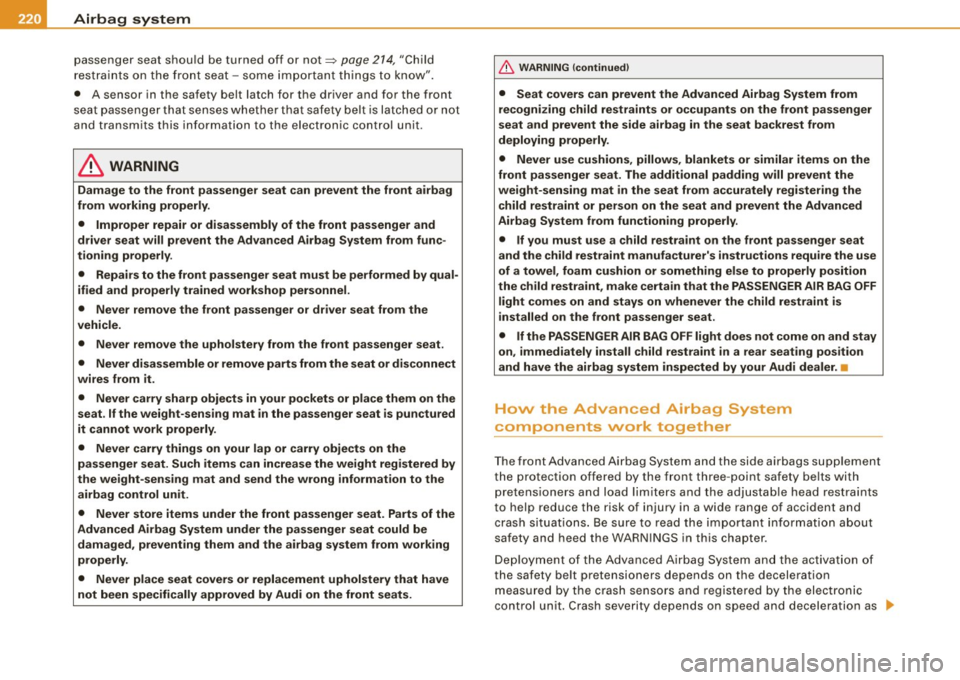
___ A_ i_r _b _a _ g~ s_ y_ s_t _e _m ___________________________________________________ _
passenger seat shou ld b e turned off or not=> pa ge 214, "Child
res train ts on the fron t seat - so m e impor tant thi ngs to kno w".
• A sensor in the safety belt latch for the driver and fo r the front
s e at pass enger that s enses w hether th at sa fet y belt is la tc hed or not
and transmits this information to the el ectron ic control unit .
& WARNING
Damage to the front passenger seat can prevent the front airbag
from working properly .
• Improper repair or disassembly of the front passenger and
driver seat will prevent the Advanced Airbag System from func
tioning properly .
• Repairs to the front passenger seat must be performed by qual
ified and properly trained workshop personnel.
• Never remove the front passenger or driver seat from the
vehicle.
• Never remove the upholstery from the front passenger seat .
• Never disassemble or remove parts from the seat or disconnect
wires from it .
• Never carry sharp objects in your pockets or place them on the
seat .
If the weight-sensing mat in the passenger seat is punctured
it cannot work properly.
• Never carry things on your lap or carry objects on the
passenger seat. Such items can increase the weight registered by
the weight-sens ing mat and send the wrong information to the
airbag control unit .
• Never store items under the front passenger seat . Parts of the
Advanced Airbag System under the passenger seat could be damaged , preventing them and the airbag system from working
properly.
• Never place seat covers or replacement upholstery that have
not been specifically approved by Audi on the front seats.
& WARNING (continued)
• Seat covers can prevent the Advanced Airbag System from
recognizing child restraints or occupants on the front passenger
seat and prevent the side airbag in the seat backrest from
deploying properly .
• Never use cushions, pillows, blankets or similar items on the
front passenger seat . The additional padding will prevent the
weight-sensing mat in the seat from accurately registering the
child restraint or person on the seat and prevent the Advanced
Airbag System from functioning properly.
• If you must use a child restraint on the front passenger seat
and the child restraint manufacturer's instructions require the use
of a towel , foam cushion or something else to properly position
the child restraint, make certain that the PASSENGER AIR BAG OFF
light comes on and stays on whenever the child restraint is
i nstalled on the front passenger seat .
• If the PASSENGER AIR BAG OFF light does not come on and stay
on, immediately install child restraint in a rear seating position
and have the airbag system inspected by your Audi dealer. •
How the Advanced Airbag System
components work together
T he front Advanced Airbag System and the si de airba gs supplement
t h e protection offered by the fro nt three -point safety be lt s with
pretensioners and load limiters a nd t he adjustab le head restraints
to help reduce the risk of in jury in a wide range of accident and
cras h situati ons. Be s ure to read the im por tant i nformation about
safety and heed the WAR NINGS in this chapter.
Depl oyment of the Adva nced A irbag Sy stem and the acti vat ion of
th e safety be lt pr etensioners dep ends on the decele ration
m easu re d by the crash se nso rs and regi stered by the e lec troni c
control unit . Crash s eve rity depends on speed and dec eleration as
~
Page 223 of 390
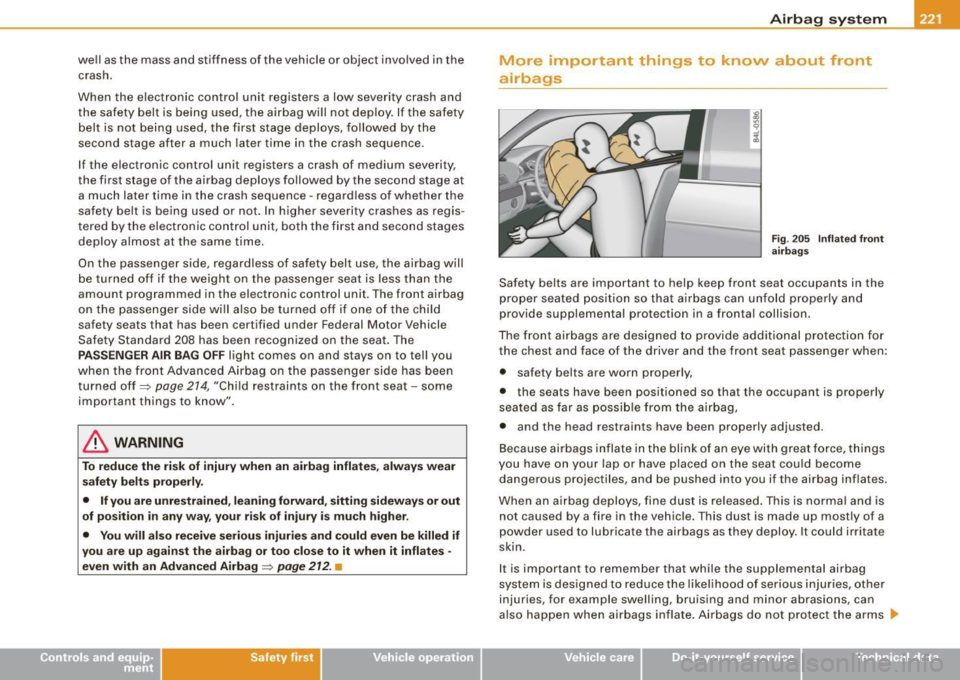
well as the mass and stiffness of the vehicle or object involved in the crash.
When the electronic control unit registers a low severity crash and
the safety belt is being used, the airbag wi ll not deploy . If the safety
belt is not being used, the first stage deploys, followed by the
second stage after a much later time in the crash sequence.
If the electronic control unit registers a crash of medium severity,
the first stage of the airbag deploys followed by the second stage at
a much later t ime in the crash sequence · regardless of whe ther the
safety belt is being used or not. In higher severity crashes as regis
tered by the e lectronic contro l unit, both the fi rst and second stages
deploy almost at the same time.
On the passenger side, regardless of safety belt use, the airbag will
be turned off if the weight on the passenger seat is less than the
amount programmed in the electronic control unit. The front airbag
on the passenger side wi ll a lso be turned off if one of the child
safety seats that has been certified under Federal Motor Vehicle
Safety Standard 208 has been recogn ized on the seat . The
PAS SEN GER A IR BAG OFF light comes on and stays on to tell you
when the front Advanced Airbag on the passenger side has been
turned off~
page 214, "Child restraints on the front seat - some
important things to know".
& WARNING
T o re duc e the ri sk of injury wh en an airb ag infla te s, a lw ay s wear
sa fet y belt s pr operl y.
• If you are unr estra ined , leanin g forw ard , s it tin g s idew ays or out
o f positi on i n a ny w ay, y ou r ris k of in jur y is much hig her.
• Yo u w ill al so rec eive seriou s injurie s and could even be kill ed if
y ou are up a gain st th e airbag or too close to it when it infl ates -
e ve n with an A dvanced Airbag~
page 212. •
Safety first
Airb ag sy ste m
More important things to know about front
airbags
F ig . 205 In fl at ed front
airb ags
Safety belts are important to he lp keep front seat occupants in the
proper seated position so tha t airbags can unfold proper ly and
provide supplemental protection in a fronta l collision.
The fron t airbags are designed to provide addit ional protection for
the chest and face of the driver and the front seat passenger when:
• safety belts are worn properly,
• the seats have been positioned so that the occupant is properly
seated as far as possib le from the airbag,
• and the head restraints have been properly adjusted .
Because airbags inflate in the blink of an eye with great force , things
you have on your lap or have p laced on the seat cou ld become
dangerous projectiles, and be pushed into you if the airbag inflates .
When an airbag deploys, fine dust is released . This is norma l and is
not caused by a fire in the vehicle. This dust is made up mostly of a
powder used to lubricate the airbags as they d eploy . It could irritate
skin.
It is important to remember that while the supplemental airbag
system is designed to reduce the likelihood of serious injuries, other
injuries, for example swelling, bruising and minor abrasions, can
a lso happen when airbags inflate. Airbags do not pro tect the arms •
Vehicle care I I irechnical data
Page 224 of 390
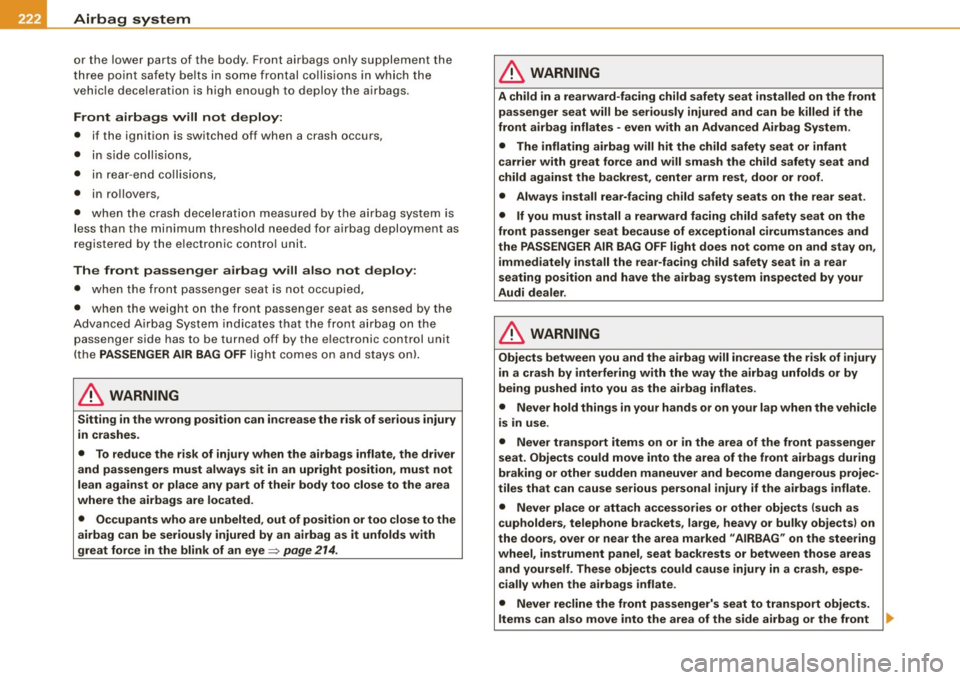
-L~A:::..:,: ir:....: b:!..::: a~g L.:: s:1y :...:s::..: t~ e:.: m:...:...:.. ________________________________________________ _
or the lower parts of the body. Front airbags only supp lement the
th ree p oint safe ty belts in som e front al co llis ions in which the
vehic le dece leration is h igh enou gh to deploy the a irba gs.
Front airbags will not deploy:
• if the ignition is switched off when a crash occurs,
• i n sid e collis io ns,
• i n rea r- e nd collisi ons ,
• in ro llovers,
• when th e c ras h de celerat io n measur ed by the a irba g system is
less than the minimum threshold needed for a irbag deployment as
r egi stere d by th e ele ctro nic con trol uni t.
The front passenger airbag will also not deploy :
• when th e fr ont pass enger seat is no t occupi ed,
• when the weight on the front passenger seat a s sensed by the
A dvanced A irbag Syste m indica tes tha t the fr ont air bag o n the
passenger side has to be turned off by the e lectronic cont rol unit
(t he PASSENGER AIR BAG OFF li gh t comes o n and s tays o nl.
& WARNING
Sitting in the wrong position can increase the risk of serious injury
in crashes .
• To reduce the risk of injury when the airbags inflate , the driver
and passengers must always sit in an upright position , must not
lean against or place any part of their body too close to the area
where the airbags are located.
• Occupants who are unbelted , out of position or too close to the
airbag can be seriously injured by an airbag as it unfolds with
great force in the blink of an eye=> page
214.
& WARNING
A child in a rearward-facing child safety seat installed on the front
passenger seat will be seriously injured and can be killed if the
front airbag inflates -even with an Advanced Airbag System .
• The inflating airbag will hit the child safety seat or infant
carrier with great force and will smash the child safety seat and
child against the backrest, center arm rest, door or roof.
• Always install rear-facing child safety seats on the rear seat.
• If you must install a rearward facing child safety seat on the
front passenger seat because of exceptional circumstances and
the PASSENGER AIR BAG OFF light does not come on and stay on, i mmediately install the rear-facing child safety seat in a rear
seating position and have the airbag system inspected by your
Audi dealer .
& WARNING
Objects between you and the airbag will increase the risk of injury
in a crash by interfering with the way the airbag unfolds or by
being pushed into you as the a irbag inflates .
• Never hold things in your hands or on your lap when the vehicle
is in use.
• Never transport items on or in the area of the front passenger
seat. Objects could move into the area of the front airbags during
braking or other sudden maneuver and become dangerous projec
tiles that can cause serious personal injury if the airbags inflate .
• Never place or attach accessories or other objects (such as
cupholders, telephone brackets , large, heavy or bulky objects) on
the doors , over or near the area marked "AIRBAG" on the steering
wheel , instrument panel , seat backrests or between those areas
and yourself . These objects could cause injury in a crash , espe
cially when the airbags inflate .
• Never recline the front passenger's seat to transport object s.
Items can also move into the area of the side airbag or the front ..,
Page 226 of 390
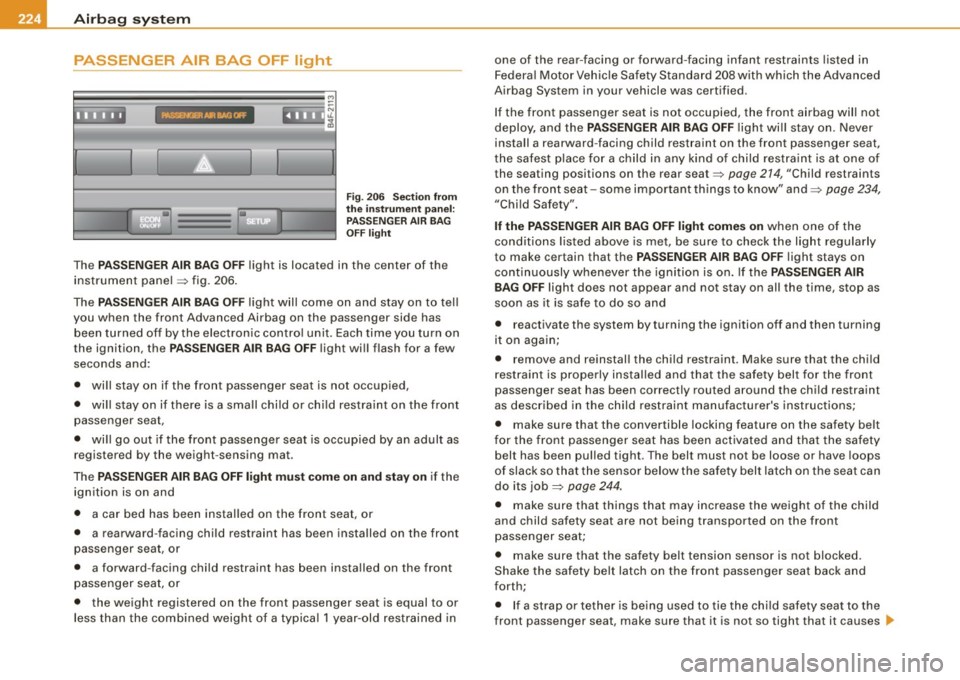
llffll,___A_ ir_ b_ a.::g <-- s--
Iii
Fig . 206 Sec tio n fr om
th e i nstrument pan el:
PAS SENGER AIR BAG
OFF light
The PASSENGER AIR BAG OFF light is located in the center of the
instrument pane l => fig. 206 .
The
PASSENGER AIR BAG OFF light will come on and stay on to tel l
you when the front Advanced Airbag on the passenger side has
been turned off by the electronic contro l unit . Each time you turn on
the ignition, the
PAS SENGER AIR BAG OFF light wi ll flash for a few
seconds and :
• will stay on if the front passenger seat is not occupied,
• will stay on if there is a small chi ld or chi ld restraint on the front
passenger seat ,
• will go out if the front passenger seat is occupied by an adult as
registered by the weight -sensing mat .
The
PASSENGER AIR BAG OFF light must come on and stay on if the
ignition is on and
• a car bed has been installed on the front seat, or
• a rearward-facing child restraint has been installed on the front
passenger seat, or
• a forward-facing child restraint has been insta lled on the front
passenger seat, or
• the weight registered on the front passenger seat is equal to or
less than the combined weight of a typical 1 year-old restrained in one of the rear
-facing or forward-facing infant restraints listed in
Federa l Motor Vehicle Safety Standard 208 with which the Advanced
Airbag System in your vehicle was certified .
I f the front passenger seat is not occupied, the front airbag wil l not
deploy, and the
PASSENGER AIR BAG OFF li ght wi ll stay on. Never
install a rearward -facing child restraint on the front passenger seat,
the safest place for a child in any kind of child restraint is at one o f
the seating posi tions on the rear seat=>
page 214, "Child restraints
o n the front seat -some important things to know" and=>
page 234,
"Chi ld Safety".
If the PASSENGER AIR BAG OFF light comes on when one of the
conditions listed above is met , be sure to check the light regularly
to make certain that the
PASSENGER AIR BAG OFF light stays on
continuously whenever the ignition is on. If the
PASSENGER AIR
BAG OFF
light does not appear and not stay on all the time, stop as
soon as it is safe to do so and
• reactivate the system by turning the ignition off and then turning
it on again;
• remove and reinstal l the child restraint. Make sure that the child
restraint is properly insta lled and that the safety belt for the front
passenger seat has been correctly routed around the child restraint
as described in the child restraint manufacturer's instructions;
• make sure that the convertible locking feature on the safety belt
for the front passenger seat has been activated and that the safety
belt has been pulled tight . The belt must not be loose or have loops
of slack so that the sensor below the safety belt latch on the seat can
do its job =>
page 244.
• make sure that things that may increase the weight of the child
and child safety seat are not being transported on the front
passenger seat;
• make sure that the safety belt tension sensor is not blocked .
Shake the safety belt latch on the front passenger seat back and
forth;
• If a strap or tether is being used to tie the child safety seat to the
front passenger seat, make sure that it is not so tight that it causes -.,
Page 227 of 390

Airbag syst em -----------------=~-
the weight -sensing mat to measure more weight than is actually on
the seat .
If th e PA SSENGER AIR BAG OFF light still d oes not come on and does
not stay on continuously (when the ignition is switched on),
• t ake the child restraint off the front passenger seat and install it
properly at one of the rear seat positions. Have the airbag system
inspected by your Audi dealer immediately.
• move the child to a rear seat position and make sure that the
child is proper ly restrained in a child restraint that is appropria te for
its size and age .
The
P AS SENGER AIR BAG OFF light shou ld NOT come on when the
ignition is on and an adult is sitting in a proper seating posi tion on
the front passenger seat . If the
PASSENGER AIR BAG OF F light
comes on and stays on or flashes for about 5 seconds whi le driving,
under these circumstances, make sure that :
• the adu lt on the front passenger seat is properly seated on the
center of the seat cushion w ith his or her back up against the back
res t and the backrest is not reclined => page 794, "Proper occupant
sea ting positions" ,
• the adult is not taking weight of f the sea t by holding on to the
passenger assist handle above the front passenger door or
supporting thei r we ight on the armrest,
• the safety belt is being proper ly worn and that there is not a lot
of slack in the safety belt webbing,
• accessory seat covers or cushions or other things that may cause
an incorrect reading or impression on the weight -sensing mat
under the upho lstery of the seat have been removed from the front
passenger sea t,
• a safety belt extender has not been left in the safety be lt latch for
t he front passenger seat .
In addition to the
PA SS ENGER AIR BAG OFF light in the center of the
instrument panel, the message
PASSENGER AIR BAG O FF o r
PAS SEN GER AIR BA G ON wi ll briefly appear in the instrument c luster
Controls and equip
ment Safety first Vehicle operation
display. This is to inform the driver of the current front passenger
a
irbag status .•
Important safety instructions on monitoring
the Advanced Airbag System
& WARNING
An airbag sy stem that is not functioning properly cannot provide
supplemental protection in a front al cra sh .
• If the airb ag ind icator li ght come s on , it me ans that there may
be something wrong with the Advanced Ai rbag S ystem. It is
po ssible that the airbag will inflate when it is not suppo sed to , or
w ill not infl ate w hen it should .
• Have the airb ag system inspe cted immediatel y by you r Audi
dealer.
& WARNING
If the front airb ag infl ate s, a child without a child re straint , in a
rear ward -fa cing child safet y se at or i n a forwa rd-fa cing child
r e str aint that has not been properly installed will be seriously
inj ured and can be killed .
• Even though your vehicle i s equipped with an Adv anced Airbag
Sy stem , m ake cert ain that all children , e speci ally 1 2 year s and
younger , alway s ride on the bac k seat prope rly re strain ed for their
a ge and siz e .
• Alway s install forward or rear -facin g child safety seats on the
re ar seat - even with an Ad vanced Airb ag System .
• If you must in stall a rearwa rd -fa cing child safety seat on the
fron t pa sse nger seat be cau se of exc eptional circu mstan ce s a nd
the PASSENGER AIR BAG OFF light doe s not appe ar and st ay o n,
immedi atel y insta ll the rear -f ac ing child safet y seat in a re ar ..,
Vehicle care Do-it-yourself service Technical data
Page 228 of 390
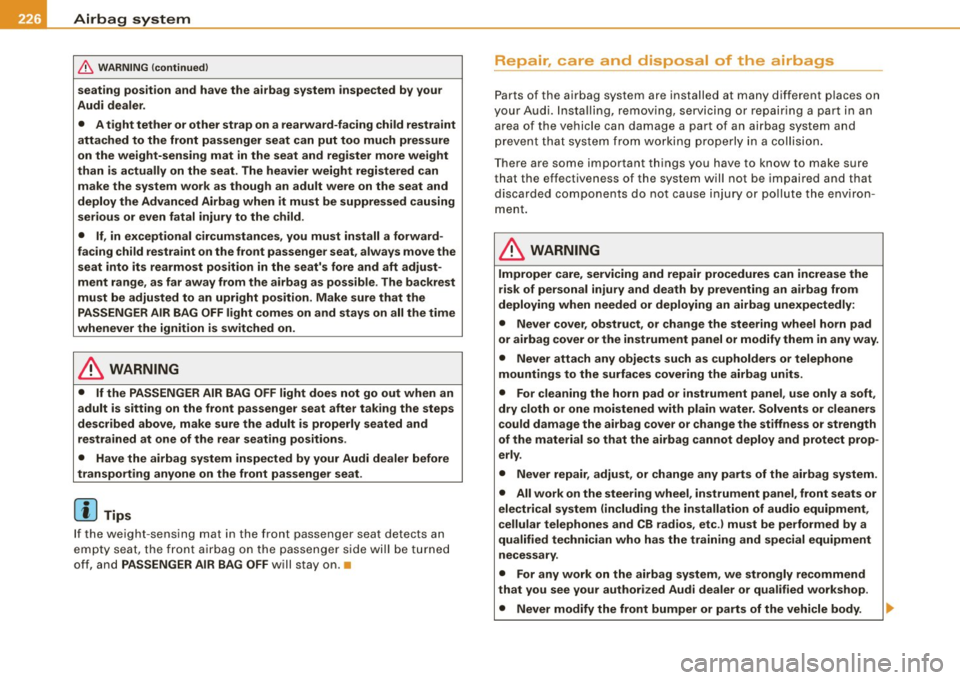
___ A_ ir_ b_ a-g _ s_y _s_ t_ e_ m _________________________________________________ _
& WARN ING (continued )
seating posit ion and have the airb ag system inspe cted by your
Audi dealer .
• A t ight tether or other strap on a rearward-fa cing child restr aint
att ached to the front pas senger se at can put too much pres sure
on the weight-sensing mat in the seat and reg ister more weight
than is actually on the seat. The heavier weight registered can
m ake the system work as though an adult were on the seat and
deploy the Advanced Airbag when it must be suppressed cau sing
ser ious or even fatal injury to the child .
• If, in exceptional circumstance s, you mu st in stall a forward
f a cing child restraint on the front passenger seat , always move the
seat into its rearmost position in the seat's fore and aft adjust
ment range , as far away from the airbag as po ssible . The ba ckrest
must be adjusted to an upright position. Make sure that the
PASSENGER AIR BAG OFF light comes on and stay s on all the time
whenever the ignition is switched on .
& WARNING
• If the PASSENGER AIR BAG OFF light does not go out when an
adult is sitting on the front passenger seat after tak ing the step s
described above, make sure the adult i s properly seated and
restrained at one of the rear seating posit ions .
• Have the airbag system inspected by your Audi dealer before
transport ing anyone on the front passenger seat .
[ i ] Tips
If the weight -sensing mat in the front passenger seat detects an
e m pty seat , the front a irbag on the passenge r side wil l be tur ned
off, and PASSENGER AIR BAG OFF will stay on.•
Repair, care and disposal of the airbags
P arts of the airbag system are installed at many different p laces on
you r Aud i. Insta ll ing, r emoving, servic ing or repa iring a pa rt in an
area of the vehicle can damage a part of an airbag system and
p revent that sys tem from working pr operly in a c ollisi on.
There are some important things you have to know to ma ke sure
t h at the effective ness of the system will not be impai red and that
discarded co mponents do not cause injury or po llute the env iro n
ment .
& WARNING
Improper care , servicing and repair procedures can increase the
risk of personal injury and death by pre venting an airbag from
deploying when needed or deploying an airbag unexpectedly:
• Never cover , obstruct , or change the steering wheel horn pad
or airbag cover or the instrument panel or modify them in any way .
• Never attach any objects such as cupholders or telephone
mountings to the surfaces covering the airbag units .
• For cleaning the horn pad or instrument panel , use only a soft,
dry cloth or one moistened with plain water. Solvents or cleaner s
c ould damage the airbag cover or change the stiffness or strength
of the material so that the airbag cannot deploy and protect prop
erly .
• Never repair , adju st, or change any parts of the airbag sy stem .
• All work on the steering wheel , instrument panel , front seats or
electrical system (including the installation of audio equipment ,
cellular telephones and CB radios , etc .I must be performed by a
qualified technician who has the training and special equipment
necessary .
• For any work on the airbag system, we strongly recommend
that you see your author ized Audi dealer or qual ified workshop .
• Never modify the front bumper or parts of the vehicle body .
Page 233 of 390
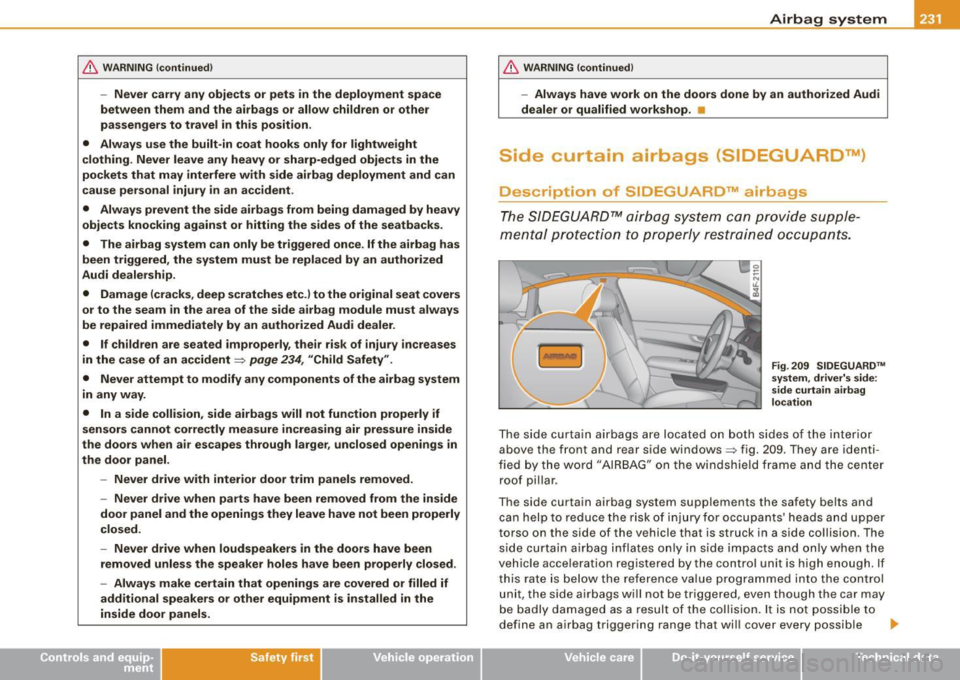
& WARNING !continued )
-Never carry any objects or pets in the deployment space
between them and the airbags or allow children or other
passengers to travel in this posit ion .
• Always use the built -in coat hook s only for lightweight
c lothing. Never le ave any heavy or sharp-edged objects in the
pockets that may interfere with side airbag deployment and can
c ause personal injury in an accident .
• Always prevent the side airbags from being damaged by heavy
objects knocking against or hitting the sides of the seatbacks .
• The airbag system can only be triggered once . If the airbag has
been triggered , the system must be replaced by an authorized
Audi deale rship .
• Damage (cracks , deep scratches etc .) to the original seat covers
or to the seam in the area of the side airbag module must always
be repaired immediately by an authorized Audi dealer.
• If children are seated improperly , their risk of injury incre ases
in the case of an accident=:>
page 234, "Child Safety".
• Never attempt to modify any components of the airbag system
in anyway.
• In a side collision , side airbags will not function properly if
sensors cannot correctly measure increasing air pressure inside
the doors when air escapes through larger , unclosed openings in
the door panel .
- Never drive with inter ior door tr im panels removed .
- Never drive when parts have been removed from the inside
door panel and the openings they leave have not been properly
closed.
- Never drive when loudspeakers in the doors have been
removed unless the speaker holes have been properly closed .
- Always make certain that openings are covered or filled if
additional speakers or other equipment is installed in the
inside door panels .
Safety first
Airbag system
& WARNING !continued )
-Always have work on the doors done by an authorized Audi
dealer or qualified workshop . •
Side curtain airbags (SIDEGUAROTM)
Description of SIDEGUARD™ airbags
The SIDE GUARD ™ airba g sy stem c an p rovide supple
m ental pro tecti on to properly re str ained occupant s.
Fig. 209 SIDEGUARD ™
sy stem , drive r's side :
side curtain airbag
lo ca tion
Th e sid e cu rtain ai rbags are loca ted on both sides o f the i nte ri or
above the front and rear side windows=:> fig. 2 09 . They are identi
fied by th e w ord "AIRBA G " o n the w indshie ld frame and the cen te r
roof pi llar.
The side curtain ai rbag system supplements the safety be lts and
ca n help t o reduce t he risk of inju ry for occupants' heads and upper
torso on the side of the vehicle that is struck in a s ide co llision. The
s ide c urtain a irb ag inf lates o nly i n side i mpac ts a nd o nly whe n the
veh ic le acce leration registered by the control unit is high enou gh. If
t his r ate is belo w th e re fer ence va lu e p ro gra mmed i nto t he con trol
un it, the side airbags will not be trigg ered , eve n though the car may
b e badl y da mage d as a r esult of th e collisio n. It is not p ossib le t o
def in e an airbag triggerin g range that wi ll cover every possible ,-
Vehicle care
I I irechnical data
Page 235 of 390

Airbag system -----------------=~-
When the system is triggered, the side curtain airbag is filled with
propellant gas and breaks through a seam above the front and rear
side windows identified by the AIRBAG label. In order to help
provide this additional protection, the side curtain airbag must
inflate within the blink of an eye at very high speed and with grea t
force. The side curtain airbag could injure you if your seating posi
tion is not proper or upright or if items are located in the area where
the supplemental side curtain airbag inflates. This applies espe
cially to children =>
page 234.
Although they are not a soft pillow , side curtain airbags can
"cushion" the impact and in this way they can help to reduce the risk
of injury to the head and the upper part of the body .
A fine dust may develop when the airbag deploys. This is quite normal and does not mean there is a fire in the vehicle. •
Important safety instructions on the side
curtain airbag system
Airbags are only supplemental restraints. Always prop
erly wear safety belts and ride in a proper seating posi
tion.
There is a lot that you and your passengers must know and do to
help the safety belts and airbags do their job to provide supple
mental prot ection.
& WARNING
Improperly wearing safety belts and improper seating positions
increase the risk of serious personal injury and death whenever a
vehicle is being used.
• Never let occupants place any parts of their bodies in the area
from which the side curtain airbags inflate.
• Always make sure that the side curtain airbags can inflate
without interference. Unsuitable accessories fitted inside the
Controls and equip ment Safety first
Vehicle operation
& WARNING (continued)
expansion range of a SIDEGUARD head airbag can dangerously
interfere with its function. A deploying head airbag develops
enough force to catapult any piece of add-on component out of its
path of inflation and into the passenger compartment. An occu
pant hit by such a projectile can suffer serious injury or death
=>
page 368 , "Technical Modifications".
• Do not swivel the sun visors to the side if you have any objects
clipped onto them (for example pens!. If the airbag should deploy,
you could be injured by these objects .
• Use the built-in coat hooks only for lightweight clothing. Never
leave any heavy or sharp-edged objects in the pockets that may
interfere with airbag deployment and can cause personal injury in
an accident.
• Never use hangers to hang clothing from the hooks.
• Only use factory-installed sun shades or, in the case of shades
installed after the vehicle leaves the factory, only Audi roll-up
sunscreens may be used => page 368, "Additional accessories and
parts replacement".
• Always sit in proper seating position and wear safety belts
while traveling so that the side curtain airbags can help provide
protection .
• The airbag system can only be triggered once. If the airbag has
been triggered, the system must be replaced by an authorized
Audi dealer or qualified workshop.
• Always have work involving the side curtain airbag system,
removal and installation of the airbag components, or other
repairs performed by a qualified dealership. Otherwise the airbag
system may not work correctly.
• Never attempt to modify any components of the airbag system
in any way.•
Vehicle care Do-it-yourself service Technical data